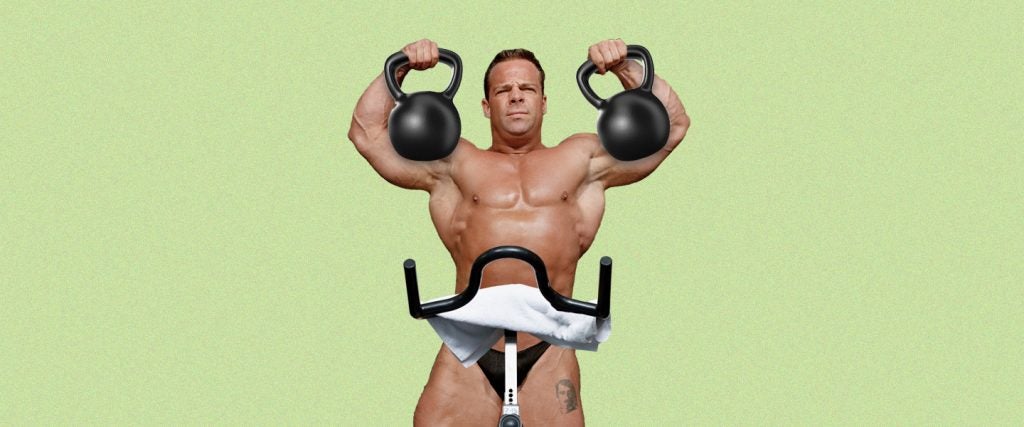Norbert, the owner and inventor of the Burn Machine, a company for which I served as chief operating officer, was never without ideas for new and novel fitness equipment. For instance, he once exclaimed out of nowhere, “We’re gonna design an exercise bike that you can spin the top of and spin the bottom of at the same time.” (In fairness, rotation and spinning was the Burn Machine’s thing.) To emphasize his point, he sat down at one of the stationary bikes we had at the office while holding a Burn Machine unit in his hands and began spinning it as he simultaneously pedaled.
He quickly noticed, however, that the rate of his hand rotation was faster than that of his feet. “We’ll have to link the two together somehow so that it isn’t so awkward,” he conceded. “But we can say it’s a great way to burn more calories and do something with your arms while you train your legs.”
I smiled and nodded, but I honestly wasn’t so sure. Yes, it might seem like your hands are better off doing something other than grasping the handlebars, resting in your lap or scrolling on your phone while you ride a stationary bike, but there’s also a chance you might be downgrading the overall effectiveness of your workout by doing so.
Downgrade the effectiveness of my workout?!?!? How could that possibly be true?
Let me count the ways for you: First of all, there are plenty of upper-body exercises that will dupe you into believing that your arms are efficient calorie-burners, when the reality is, they’re quite puny in relation to the other muscles in your body, and wildly inferior at burning calories in comparison to your legs.
Moreover, most of the supposed upper-body calorie burners that people cite when talking about torching calories with your arms are actually total-body movements, like sledgehammer swings, battle rope slams and swimming with a pool buoy between your legs. Basically, it can be difficult to isolate the caloric burn attributable solely to the movement of the arms.
I noticed you didn’t say impossible, though.
That’s very astute of you. One of the best ways to isolate the greatest benefit of arm cardio is through an arm ergometer. The compendium of MET values has assigned a difficulty score of 2.8 to average arm ergometer movement, compared with a general score of 7.0 applied to stationary biking. In other words, your arms are going to be far less than half as effective at burning calories as stationary biking when they’re essentially attempting the same exercise function. Please keep in mind, too, this is a best-case scenario where resistance is being applied to your arms in a way that’s ergonomically conducive to their movement.
Also, when you link the movement of the arms and legs together so that they’re in sync, it’s not like you can add the scores together and think that you’ve elevated your training intensity. In actuality, the natural tendency is for the motion of your legs to slow down so that the arms can keep pace. And so, like I mentioned earlier, the efficiency of the legs is diminished and you typically end up burning fewer calories than you would have if you’d strictly focused on cranking away with your feet as forcibly as possible.
Yes, I realize that calories aren’t everything; sometimes it’s about conditioning your upper body to handle a specific type of workload. But calorie burning is of foremost importance to a great many people, and spinning the arms in the pursuit of a faster calorie burn usually results in ground being lost overall.
What about if I just move my arms around a bit?
You mean flailing them through the air without any resistance? Aside from keeping your upper body loose, this isn’t going to do much. Swinging your arms is of debatable benefit even when you’re just walking. While some researchers have suggested that aggressive arms swings may help you to burn up to 15 percent more calories during your workout — with the high-end projection being attributed to the idea that an arm-pumping motion will automatically cause you to speed up your pace — others have said it takes more effort not to pump your arms while you walk at a fast pace (not that they advise you to do that either).
If you really want to maximize your time and do something with your arms while you’re riding a stationary bike, I suppose you could grab a set of small weights and take yourself through what in all likelihood will be a very light shoulder or bicep routine while you’re pumping away at the pedals. They’ll need to be light weights out of necessity, because any weights that are hefty enough to tax your arms into hypertrophy and elicit serious muscle growth are also prone to disrupt your balance, which could be catastrophic under the circumstances.
As my personal training buddy Rudy loved to say, “I love Jack Daniels and I love Coca-Cola, but when you mix them together, you ruin them both.” With that in mind, I’d separate out your arm workouts from your bike workouts. Because 20 minutes of focused biking followed by 10 minutes of efficient upper-body training is vastly superior to 30 minutes of mixed mediocrity.

